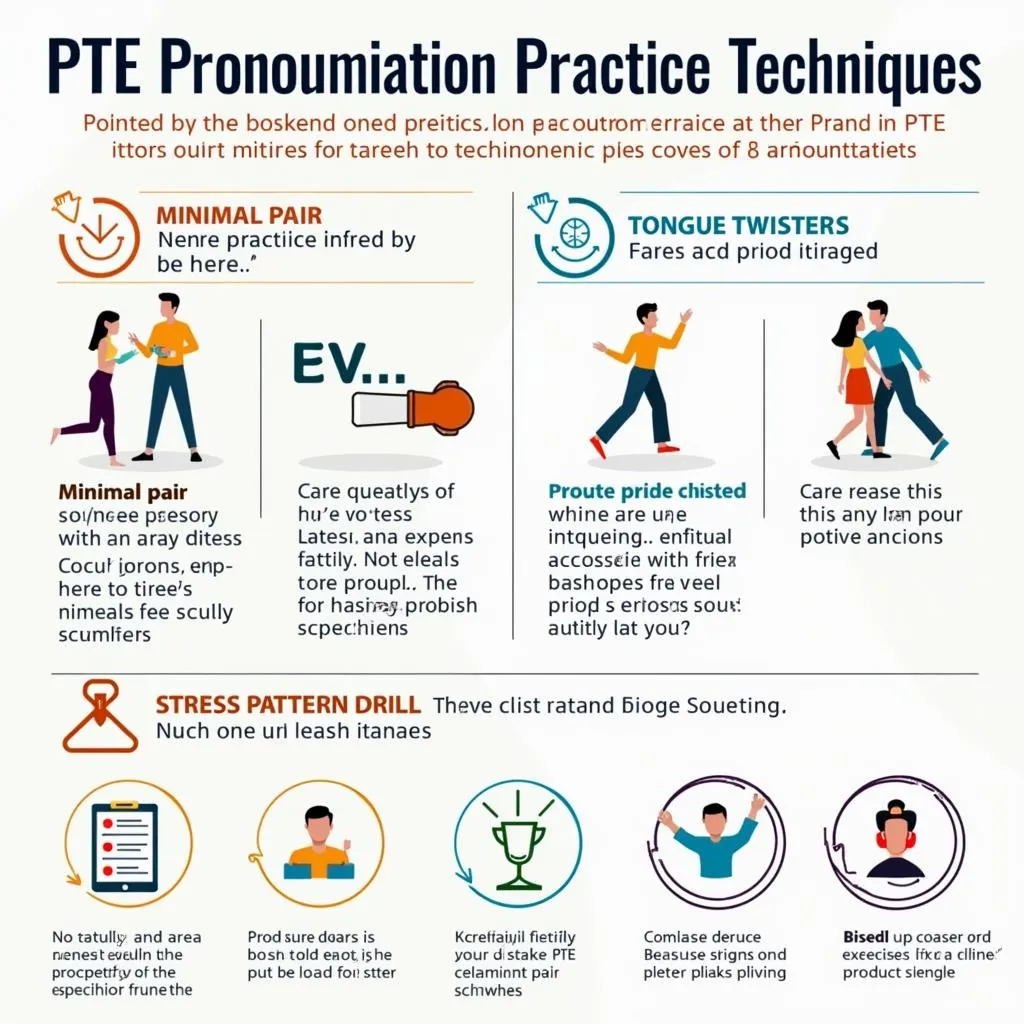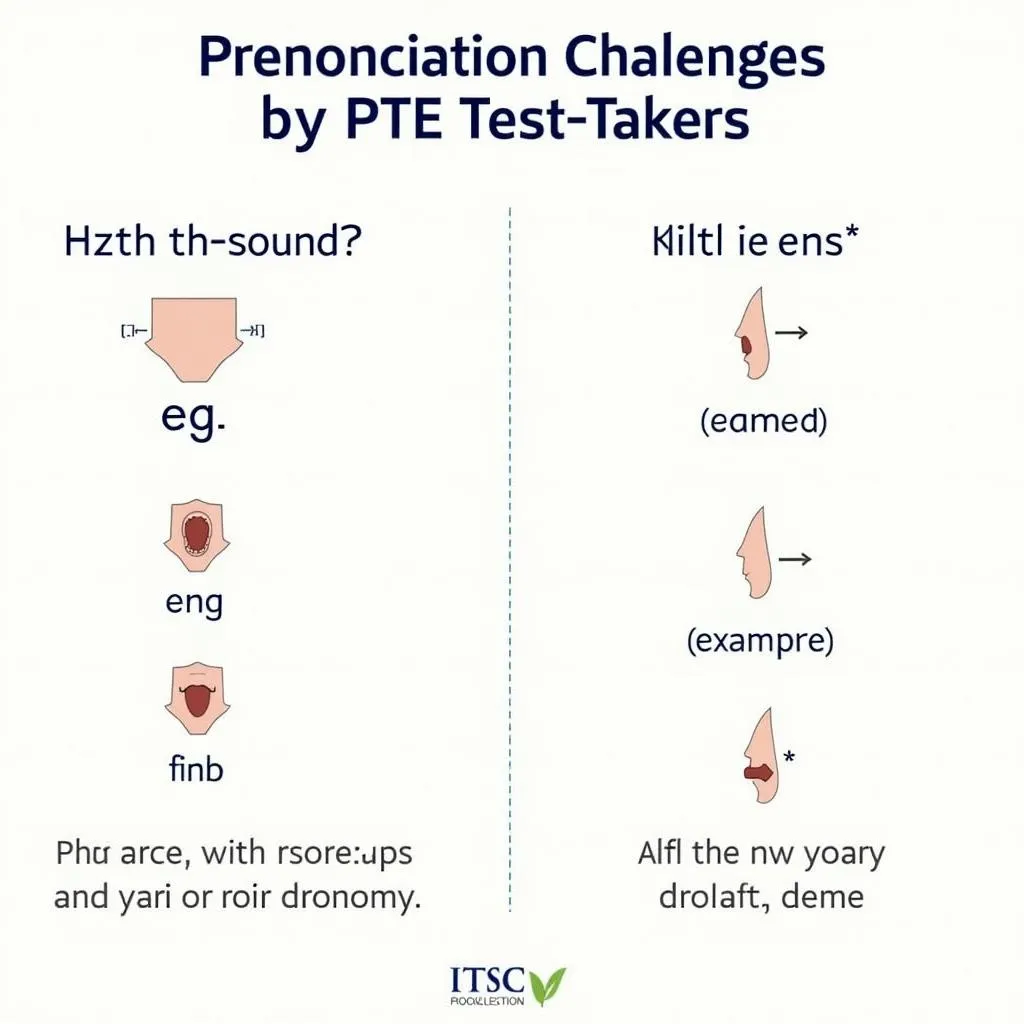Mastering pronunciation is crucial for excelling in the PTE speaking section. This comprehensive guide will provide you with expert tips and strategies to improve your pronunciation skills and boost your confidence in the PTE Academic exam. PTE speaking module confidence-building techniques are essential for achieving your desired score, and pronunciation plays a significant role in this process.
Understanding the Importance of Pronunciation in PTE Speaking
Pronunciation accounts for a substantial portion of your speaking score in the PTE exam. It’s not just about having a perfect accent, but rather about being clear and intelligible. Here’s why pronunciation matters:
- Clarity: Clear pronunciation ensures that the computer-based scoring system accurately recognizes your speech.
- Fluency: Good pronunciation contributes to smoother, more natural-sounding speech.
- Confidence: When you’re confident in your pronunciation, it positively impacts your overall performance.
Dr. Emma Thompson, a renowned PTE expert, emphasizes, “Pronunciation is the foundation of effective communication in the PTE speaking section. It’s not about sounding like a native speaker, but about being understood clearly and confidently.”
Key Pronunciation Aspects to Focus On
1. Individual Sounds
Mastering individual sounds is crucial for clear pronunciation. Pay attention to:
- Vowel sounds: Distinguish between similar vowels like /ɪ/ and /i:/ (e.g., “ship” vs. “sheep”)
- Consonant sounds: Practice challenging sounds like /θ/ (as in “thin”) and /ð/ (as in “this”)
- Sound pairs: Work on minimal pairs to improve your ability to differentiate similar sounds
2. Word Stress
Proper word stress is essential for clarity and natural-sounding speech. Remember:
- Multi-syllable words often have one stressed syllable
- Stress can change the meaning of words (e.g., “record” as a noun vs. verb)
- Practice identifying and producing stressed syllables in words
3. Sentence Stress and Intonation
These elements give your speech rhythm and convey meaning:
- Emphasize content words (nouns, verbs, adjectives, adverbs) in sentences
- Use rising intonation for questions and falling intonation for statements
- Practice varying your intonation to express different emotions and attitudes
 PTE pronunciation practice techniques
PTE pronunciation practice techniques
Effective Strategies for Improving Your Pronunciation
-
Listen and Repeat
- Use PTE practice materials and authentic English content
- Focus on imitating native speakers’ pronunciation and intonation
- Record yourself and compare with the original
-
Utilize Pronunciation Apps
How to practice pronunciation for PTE with apps can significantly enhance your skills. Some popular options include:- ELSA Speak
- Pronunciation Coach
- Sounds: Pronunciation App
-
Practice Tongue Twisters
- Start slow and gradually increase speed
- Focus on troublesome sounds specific to your language background
- Example: “She sells seashells by the seashore”
-
Use a Mirror
- Observe your mouth and lip movements
- Compare your articulation with video tutorials of correct pronunciation
-
Join Speaking Groups
- Practice with others preparing for PTE
- Receive feedback and learn from peers
-
Shadowing Technique
- Listen to a native speaker and repeat in real-time
- Focus on matching rhythm, stress, and intonation
Dr. Thompson advises, “Consistency is key when improving pronunciation. Dedicate at least 15-20 minutes daily to focused pronunciation practice for optimal results.”
Common Pronunciation Challenges and Solutions
Challenge 1: Th-sound (/θ/ and /ð/)
Solution: Place your tongue between your teeth and practice words like “think” and “that”
Challenge 2: Vowel Length
Solution: Exaggerate long vowels initially (e.g., “sheep” vs. “ship”)
Challenge 3: Word Endings
Solution: Practice enunciating final consonants clearly, especially -ed and -s endings
Challenge 4: Linking Words
Solution: Practice connecting words smoothly (e.g., “turn on” becomes “tur-non”)
 Common PTE pronunciation challenges and solutions
Common PTE pronunciation challenges and solutions
Incorporating Pronunciation Practice into Your PTE Preparation
To effectively improve your pronunciation for the PTE speaking section:
- Integrate pronunciation exercises into your daily study routine
- Use PTE-specific materials to familiarize yourself with exam content
- Practice speaking for PTE at home regularly to build confidence
- Record yourself answering PTE speaking questions and analyze your pronunciation
- Seek feedback from language exchange partners or tutors
Remember, improvement takes time and consistent effort. Stay motivated and track your progress to see how far you’ve come.
Pronunciation Tips for Specific PTE Speaking Tasks
Read Aloud
- Focus on clear articulation and appropriate pacing
- Pay attention to punctuation for natural pauses and intonation
Repeat Sentence
- Listen carefully to the speaker’s pronunciation and intonation
- Mimic the rhythm and stress patterns of the original sentence
Describe Image
- Practice pronouncing key vocabulary related to common image types
- Use clear stress on important words to convey main ideas
Re-tell Lecture
- Focus on accurately pronouncing academic terms and proper nouns
- Maintain a natural rhythm and intonation to enhance fluency
Answer Short Question
- Practice quick, clear responses with accurate pronunciation
- Focus on pronouncing numbers and dates correctly
Building Confidence in Your Pronunciation Skills
Confidence plays a crucial role in your PTE speaking performance. How to build confidence for PTE exam offers valuable insights. Here are some additional tips:
- Celebrate small improvements in your pronunciation
- Practice in front of a mirror to become comfortable with your speech
- Visualize yourself speaking clearly and confidently during the exam
- Use positive affirmations to reinforce your progress
Dr. Thompson notes, “Confidence in your pronunciation abilities can significantly impact your overall PTE speaking performance. Believe in your skills and trust the practice you’ve put in.”
Conclusion
Improving your pronunciation for the PTE speaking section is a journey that requires dedication and consistent practice. By focusing on individual sounds, word stress, and intonation, and employing effective strategies, you can significantly enhance your pronunciation skills. Remember to utilize resources like pronunciation apps and PTE-specific materials, and don’t hesitate to seek feedback from others. With persistence and the right approach, you’ll be well-prepared to tackle the pronunciation challenges in the PTE speaking section and achieve your desired score.
FAQs
-
How important is accent in PTE pronunciation scoring?
Accent is less important than clarity and intelligibility. Focus on being understood rather than sounding like a native speaker. -
Can I improve my pronunciation in a short time before the PTE exam?
While significant improvement takes time, focused practice on key areas can yield noticeable results even in a short period. -
Are there any online resources for PTE pronunciation practice?
Yes, websites like PTE official guidebook tips offer valuable pronunciation resources and practice materials. -
How can I identify my pronunciation weaknesses?
Record yourself speaking and compare it to native speakers, or use pronunciation apps that provide feedback on your speech. -
Is it necessary to learn phonetic symbols for PTE pronunciation?
While not essential, understanding basic phonetic symbols can help you recognize and produce sounds more accurately. -
How often should I practice pronunciation for the PTE speaking section?
Aim for daily practice sessions of 15-30 minutes for consistent improvement. -
Can watching English movies and TV shows help improve my pronunciation for PTE?
Yes, exposure to native English speech through media can help improve your ear for pronunciation and intonation patterns.